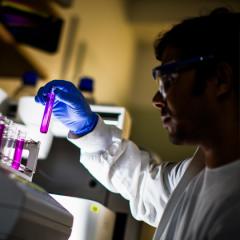
UQ researchers are investigating the role played by genetic mutations which cause an extremely rare neurodegenerative disease. The Wolvetang laboratory at AIBN recently found that key areas of the brain affected in this disease can be recreated in the lab using patient-derived stem cells, and this has now been published in the journal Frontiers in Cellular Neuroscience.
A-T is an inherited disorder that affects the nervous system and immune system of children, progressively debilitating motor control and weakening the body’s ability to fight infections. A-T patients also suffer from an increased predisposition to cancer.
A-T occurs in approximately one in 40,000 to 100,000 people worldwide. Those who with suffer from the disease have an average life expectancy of just 25 years. There is currently no cure for A-T, nor any significant treatment known to slow the progression of the disease.
AIBN researcher Dr Sam Nayler who was the first author on this publication has been awarded the prestigious two-year Oxford Nuffield Medical Fellowship to study the mechanisms underlying ataxia-telangiectasia (A-T), also known as Louis-Bar syndrome, and is now continuing this research at Oxford University.
“It’s a terribly debilitating disease with fatal consequences. The first signs of A-T appear during early childhood, and most suffers are wheelchair-bound by their teens. The symptoms become progressively worse with time,” Dr Nayler said.
“Children with the disease develop difficulty walking, problems with coordination, and disturbances in nerve function. Health complications arise when normal swallowing, eating and breathing is compromised, making them highly susceptible to pulmonary infections. Their immune system is compromised, and cancer is very common.”
A-T is an autosomal recessive disorder caused by a defect in the ataxia-telangiectasia mutated (ATM) gene – a gene involved in repairing damage to DNA. However, the exact mechanism by which defects in the ATM gene disrupts the body’s normal nervous and immune system function remains unknown.
The Wolvetang laboratory used an approach pioneered by Nobel Prize-winning stem cell researcher Professor Shinya Yamanaka that takes samples of skin from patients and reprograms them to become induced pluripotent stem cells (iPSCs), which can then be grown into virtually any cell type. In this case the technology was used to produce cerebellar neurons in an effort to better understand the mechanisms underlying the disorder.
“A-T is a rare disease, which makes it difficult to study,” said Prof Wolvetang who led this research, ““There are a slew of animal models available, but none of these clearly recapitulate the neurological aspects of the disease. That’s why making a human stem cell model is so valuable and unique.”
”By propagating iPSCs, the goal is to develop a human model system that can be used to examine the consequence of ATM mutation in a controlled laboratory environment in a cell type relevant to the disease with the aim of identifying drugs that can help these children,” he said.
The Fellowship awarded to Dr Nayler now allows him to work in the Oxford University laboratory of Professor Esther Becker, a leading scientist who studies cerebellar ataxias. Dr Nayler hopes to combine this expertise with his experience in using human-derived iPSCs.
After two years at Oxford University, Dr Nayler will return to Australia – bringing with him new insights and novel techniques – to continue this important line of research.
“Currently, no researchers in Australia, except for the Wolvetang laboratory, are working on human iPSC-derived cerebellar neurons, so my aim is to return home from Oxford and make a significant mark in this space,” he said.
“The end goal is to produce a model of the disease with which we can use to screen shortlists of potential therapeutic agents, which could halt the disease and improve the quality of life of these people. But first we really need to understand it,” Prof Wolvetang concurred.
A-T research in AIBN’s Wolvetang Group is a collaborative effort with Professor Martin Lavin’s laboratory at the UQ Centre for Clinical Research and is supported by the BrAshA-T charitable foundation. Other collaborators include Dr Joseph Powell at the UQ Institute for Molecular Bioscience, and Professor Christine Wells at Melbourne University. The Oxford Nuffield Medical Fellowship is funded by the Nuffield Dominions Trust, and administered by the Australian Academy of Science.
Research into A-T is one of several stem cell research projects currently underway at AIBN, aimed at delivering improved regenerative health outcomes for society.


